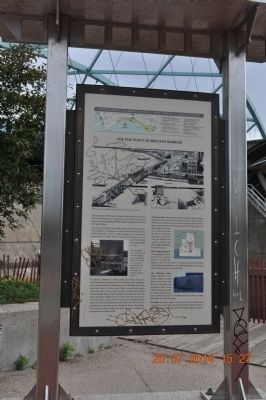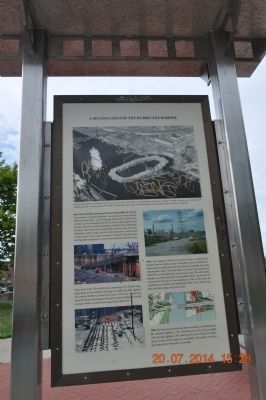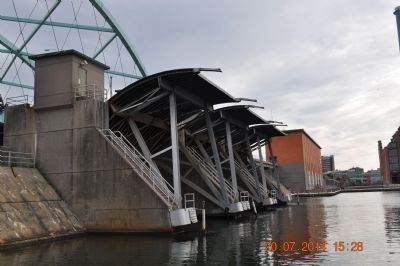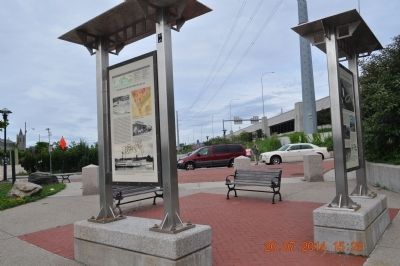Fox Point in Providence in Providence County, Rhode Island — The American Northeast (New England)
The Fox Point Hurricane Barrier / A Second Life for the Hurricane Barrier
Inscription.
Providence Harbor walk at Fox Point & India Point
1. Fox Point and Night Boat Era 1822-1932 Firefly challenges the Stagecoach Era.
2. Colonial Wharf at South Water Street: 1910-1942
3. Fox Point Hurricanes Barrier 1961-1966 Construction and 2005-2007 changes from I-I95 relocation
4. Providence River Bride Its design, construction and journey up Narragansett Bay by tugboat
5. Shipping Expands around the Point
6. Fox Point: the 19th Century Port of Providence Downgrades from goods and passengers to coal and scrap metals
7. Welcome to India Point Park
8. Welcome to Fox Point
9. Tockwooten and the Indiamen Ship building and trade with Orient India Point
10. Sails to Rails 1835: Providence’s First Train Station
11. Bridging the Seekonk
12. Rogers Williams Landing 1636
The hurricanes of 1938 and 1954 left vast devastation to property and loss of human lives. To prevent a repeat of this unexpected disaster, the city prepared to defend itself by building the Fox Point Hurricane Barrier.
As soon as a hurricane or any major storm causes waters to rise-when people are stocking up on all the milk and bread they can find in the stores –seven or eight members of the Providence Department of Public Work’s Engineering Division start to put the Fox Point Hurricane Barrier to work.
This is Exchange Place during the 1938 Hurricane, looking toward the Biltmore Hotel and City Hall. The streets were virtually alive with floating cars, and all around were strings of swamped trolley cars. The barrier, completed in 1966, extends from Allens Avenue to India Point Park to protect the city of Providence from flooding by the Providence River and Narragansett Bay. Flooding may result from heavy rains or a “storm surge,” when a coastal storm pushes water up the Bay. A storm surge becomes a critical problem when it rides the high tide, as it did during the hurricanes of 1938 and 1954. The barrier defends the city in two ways: first, it stops the storm surge from coming into the city; second, a pumping station pumping the river’s water up and through he barrier into the Bay. This concept is fairly simple, but there are some complicated components that make it work.
The River Gates:
The hurricane barrier contains three openings, through which both the river’s water and small boats can pass. When a storm threatens the city with flooding, 40 foot by 40 foot gates are lowered over the openings to ward off the surge. The gates weight 53 tons and curve outward toward the Bay to break the impact of the waves. They are lowered and raised by chains, and take roughly 30 minutes to be put in place.
The Pumping Stations:
The pumping
station houses five pumps, which are among the largest in the world. In case of an upriver flood from torrential rains, the pumps would move over 3,000,000 gallons of water per minute away from the city into the Bay.
The Vehicular Gates:
Spaces were left in the barrier’s dikes at Allens Avenue and South Main Street for vehicular and pedestrian traffic. During a flood, these spaces must be sealed and vehicular gates do this job. The gates, 13 feet high and 76 feet wide, are swung manually and locked into place.
The Dikes:
Two dikes made of armor stone (a dense, impervious type of rock) extended inland from the Providence River’s banks to where the land is 25 feet above sea level- high enough to contain a storm surge.
(Side 2)
The Hurricane Barrier was the first structure of its type in the United States to be approved for construction. A pioneer in design, criteria for such a project in this challenging geology were hard to find in the 1960s. The cofferdam shown above would be drained of water and mud to allow construction in the river.
How do you build a hurricane barrier in the middle of a river?
First construct a cellular cofferdam- an enormous looped wall that holds the water back – by driving huge hollow tubes (called cells) as wide as 57 feet through about 20 feet of river mud. Make sure the circular cells reset securely on hardpan, well below the shifting silt.
Fill them with a mixture of granular fill and river water. From the cofferdam’s center, pump out the water and mud. Construction can then begin. Drive trucks in and out of the area on long ramps, carrying heavy equipment, construction material and work crews. Next, drive some 700 steel H-piles, measuring 70 to 80 feet long, deep down to the bedrock. Like legs on a table, the piles support the massive 80,000-ton hurricane barrier. Steel was chosen over concrete because the designers found it would not displace the silt as much, which would become liquid when disturbed.
In 1966: The original 3,000-foot hurricane barrier extended from Benefit Street to Allen Avenue. It included a total of 2,000 feet of stone berms on either side of the river that were virtually tow-story impenetrable walls. This stone dike at Fox Point (pictured above) effectively cut off pedestrian access to the water. The only public passage was on the East Side at South Main Street. Access was not an issue when the barrier was completed in 1966. At the time, the waterfront was derelict and abandoned. What is now India Point Park was then a large scrap metal yard.
2006:
The hurricane barrier stone berms served as a foundation for the relocated highway I-195. This dual use of the land, coupled with moving the highway I-195, freed up
45 acres of land for urban space. Access to the water was expanded – the public may now pass along three streets and a river walk.
Topics. This historical marker is listed in these topic lists: Charity & Public Work • Disasters • Industry & Commerce • Roads & Vehicles • Science & Medicine • Waterways & Vessels. A significant historical year for this entry is 1835.
Location. 41° 49.011′ N, 71° 24.074′ W. Marker is in Providence, Rhode Island, in Providence County. It is in Fox Point. Marker is on Gano Street. Marker is located In the India Point Park before you get to the Hot Club. Touch for map. Marker is in this post office area: Providence RI 02903, United States of America. Touch for directions.
Other nearby markers. At least 8 other markers are within walking distance of this marker. Colonial Wharf at South Water Street: 1910-1942 / Fox Point and the Night Boat Era 1822-1932 (here, next to this marker); Providence River Park (within shouting distance of this marker); Providence River Bridge (about 400 feet away, measured in a direct line); Fox Point Veterans Memorial (about 700 feet away); Fox Point Cape Verdean Community (approx. ¼ mile away); Early History and Archaeology of Central Wharf (approx. 0.3 miles away); Central Wharf Shipping, Whaling, and Other Industries (approx. 0.3 miles away); Fox Point: The 19th Century Port of Providence / Shipping Expands Around the Point (approx. 0.3 miles away). Touch for a list and map of all markers in Providence.
Credits. This page was last revised on May 8, 2023. It was originally submitted on August 4, 2014, by Sandra Hughes Tidwell of Killen, Alabama, USA. This page has been viewed 555 times since then and 13 times this year. Photos: 1, 2, 3, 4. submitted on August 4, 2014, by Sandra Hughes Tidwell of Killen, Alabama, USA. • Bill Pfingsten was the editor who published this page.



